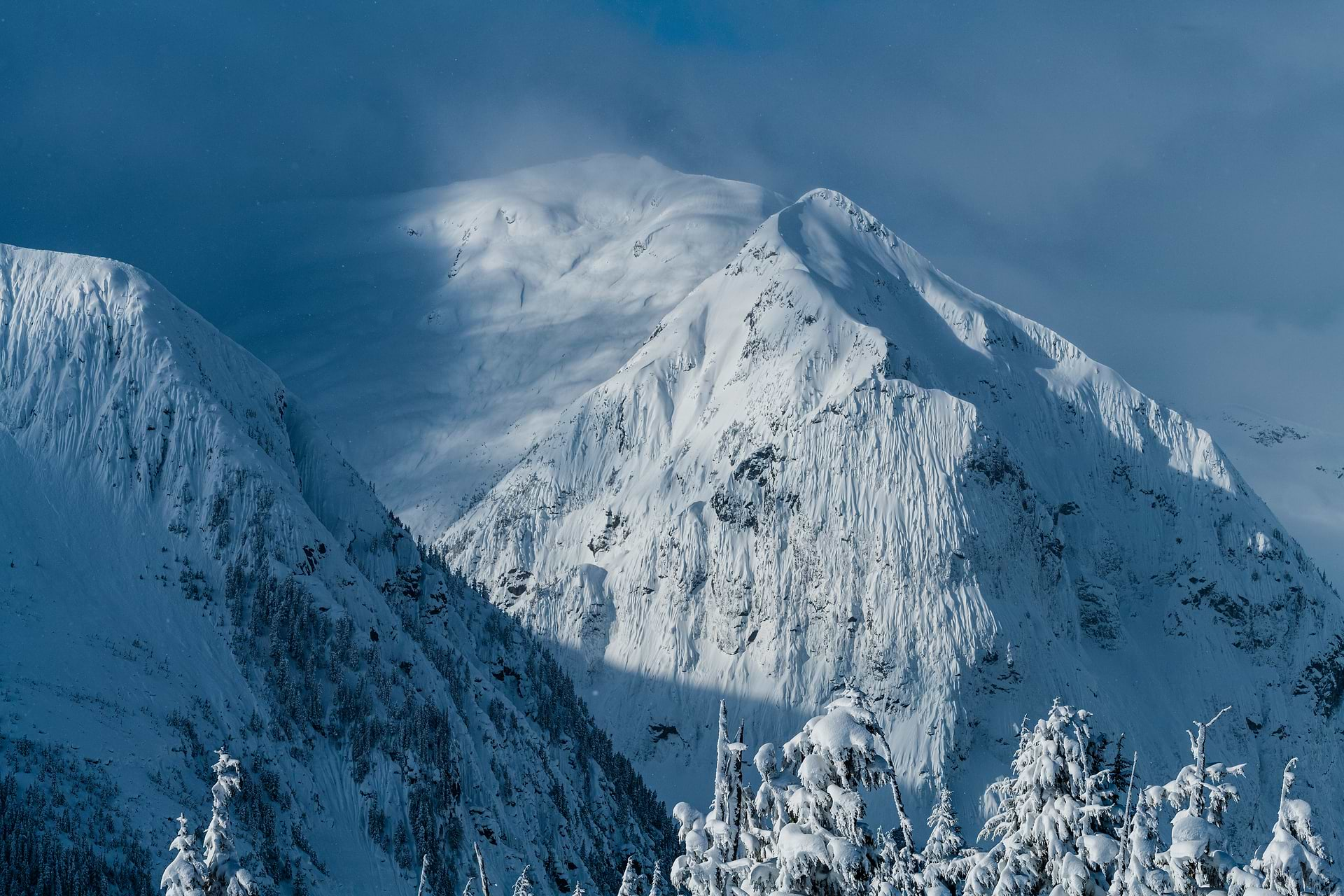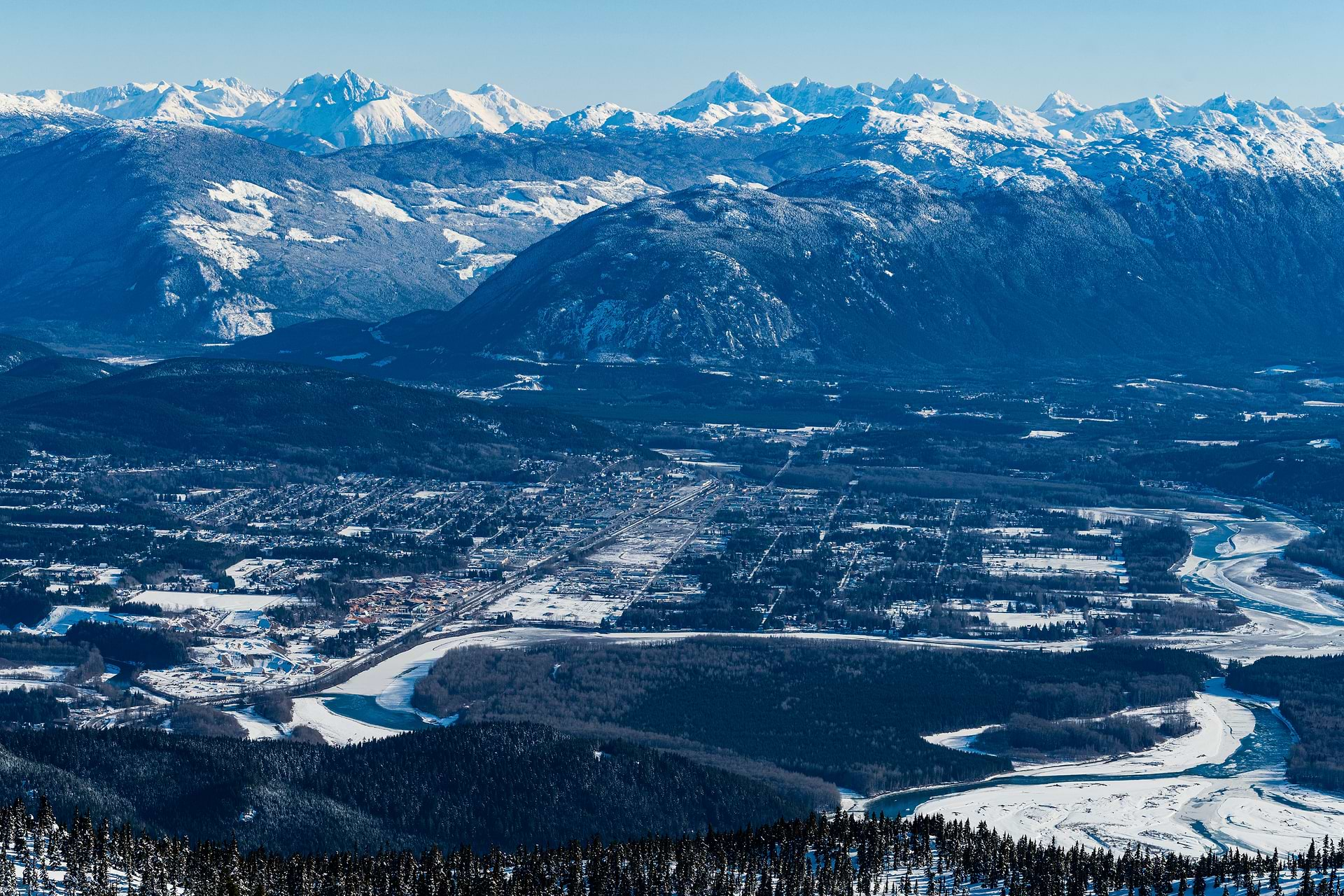

you skate off the T-bar into the kind of fat flakes that ski dreams are made of. Go left, and you’ll drop through out-of-bounds glades, part of what’s been called the best slackcountry in North America. Go right, and it’s thigh-deep plunges down one of Shames’ infamous double blacks — mechanical bulls of stumps and rock that need at least three feet of base to be skiable. On a typical snowy day, however, it feels more like swimming with dolphins as you drop in and out of the depths, gulping air at every turn.
After several runs, you haven’t yet competed for lines or face shots with anyone. As the clouds clear to show a Himalayan landscape of glacial cirques, mountains, and deep valleys, superlatives escape your lips. Days like this—so serene and uncrowded—may be commonplace for locals, but for visitors, they feel worth shouting about from the rooftops.

A rustic, seriously remote, snow-choked ski area averaging 12 metres annually, Shames isn’t owned by some far-off corporation or conglomerate. Instead, it has operated since 2013 as Canada’s only non-profit community ski cooperative. It is a picture of grassroots ski culture painted by legendary characters who could provide a cartoonist with fodder for a lifetime. Here, a tight-knit cadre of skiers reflects the community ethos of affordability, sustainability, collaboration, and innovation. Uniformly clad in seriously worn outerwear, it’s obvious they support community rather than brands — always looking out for each other, exchanging snow pack information, pitching into shovel or push at the parking lot … and gathering in the homey base lodge to wolf plates of poutine and local craft beer together.
If space is the final frontier in skiing, Shames is its own planet.

Snow has never been a problem at Shames, but isolation (a 15-hour drive from Vancouver) and low skier numbers have blessed and cursed the hill from day one. Skier: Leah Evans

Three lifts service the hill; the only chair is a long-retired lift from Whistler.

Shames in a nutshell—majestic Himalayan landscapes of glacial cirques and towering mountains carved by profound valleys.
The co-op marks the newest chapter in a long history of maintaining skiing in Terrace, a resource town known for cycles of boom and bust. Organized skiing started here in the 1960s when local entrepreneur Bill Little installed a rope tow at Northern Heights Ski Hill. Initially just a simple toboggan run, it gained popularity, leading to calls for a more developed ski area. In the early 1970s, local officials and Olympic skier Nancy Greene were invited to ride an old telephone-company snowcat up a radio-tower hill on the town’s north side. The snowcat got stuck partway up in deep snow, which was seen as a positive sign. This experience helped pave the way for the opening of Kitsumkalum Ski Hill in the winter of 1975. Despite that initial reconnaissance, however, Kitsumkalum’s 13-year stint was anything but glorious. With 15 runs covering 1,460 feet of vertical and a slightly higher summit, it quickly fell victim to a changing climate that reduced ski terrain at lower elevations and ultimately closed for good in 1988.
Although Kitsumkalum didn’t survive, it successfully fostered a local ski culture. Its infrastructure—lifts, lodge, groomer—was bought by local entrepreneurs who formed Shames Mountain Ski Corporation, developed a resort plan, secured a government loan, and relocated the entire operation half an hour west of town to an upper flank of the Shames River Valley at a more suitable base elevation of 2,300 feet, where snow measurements in the 1970s showed totals exceeding 80 feet annually.
Indeed, Shames’ inaugural opening in December 1990 became the stuff of legends when it was delayed by the groomer burying itself in thirteen feet of snow. That season, the area received a whopping 77 feet and still averages 40 feet annually.

Adrien Grabinski, Maia Bird, and Sky are three of the community members who own Shames Mountain together.



Snow has never been a problem at Shames, but its seclusion and low skier numbers have both been a blessing and a curse from the very beginning. It’s a 15-hour drive from Vancouver, and low skier numbers have both benefited and challenged the hill from the start. Years ago, financial difficulties caught up with it, and rumours circulated that it might shut down permanently. A local group quickly stepped in to purchase the operation and run it as a co-op. Shames still averages only about 350 skiers over four days each week it's open, rarely surpassing 600. Many of these visitors use lifts primarily to access surrounding plateaus and ridges that offer more than 30 separate backcountry routes. Additionally, the ski area has embraced the backcountry experience by offering avalanche courses, developing backcountry route maps, providing an uphill season pass, renting touring gear, and educating skiers through beacon check gates and hazard signage.



Alongside the allure of Shames, Northern Escape Heli Skiing, Skeena Cat Skiing, and Hankin-Evelyn Backcountry Recreation Area are attracting more skiers to the region. To meet demand, changes are coming to Shames — but not in the form of restaurants, hotels, or shopping. The only change is more skiing, as Shames recently introduced a series of unique 600-metre slackcountry runs on a frontside wooded ridge, created through community efforts and passion.
Another set of dreams for a stormy day. Look for it on Google Maps — way up there near Alaska. And get in on the secret stash — while it’s still a secret.

(population control)
(powder preservation)
(world class)

(getting there is a journey)
(like, really slow)
(like almost none)

LESLIE ANTHONY is a writer and editor who knows a thing or two about snow. Longtime Creative Director of SKIER, former Managing Editor of POWDER, and author of the book White Planet: A Mad Dash Through Modern Global Ski Culture, the resident of Whistler, British Columbia, continues to appear regularly on the masthead of the world’s top ski magazines. His favorite activity? Skiing powder, of course.
RELATED STORIES